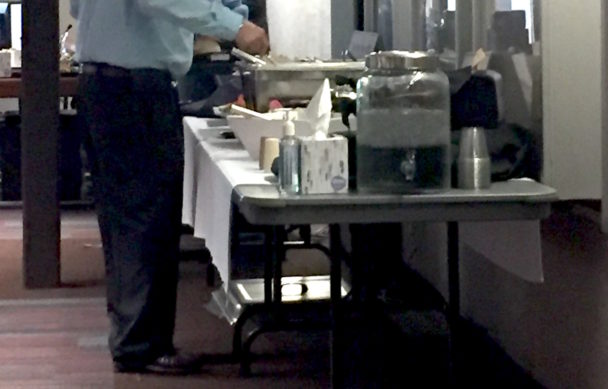Voters Choose the RTD Board, But the RTD Board Still Doesn’t Show Voters How It Operates

There’s one thing that RTD Board of Directors meetings never do without: A buffet.
Week after week, without fail, a table cluttered with food awaits board members and staffers at the Tuesday evening board meeting. Hot barbecue sandwiches, dinner rolls, salad — it’s chow time. A stern sign reminds members of the public to keep their hands off. Dinner is for elected board members and RTD staffers only!
Is this a big expense in the grand scheme of things? Of course not. But it says something that RTD’s weekly buffet always goes off without a hitch, while another small expense that’s far more relevant to the agency’s mission languishes: online broadcasts of board meetings.
RTD is one of the few American transit agencies run by elected officials, not appointees. The agency is supposed to rely on an informed public. And yet there is no way for the public to see or hear the discussion taking place, even in an age when it’s easy to broadcast video live from a mobile device.
Streetsblog first broached the subject in 2015. Allan Wallis, a professor of public affairs at University of Colorado Denver who specializes in local government, told Streetsblog that meeting minutes are the bare minimum of government transparency. And a 2015 memo estimated the cost of full visual and audio transparency at just $35,000 a year [PDF], but the board still voted down the transparency measure 8-4.
Back then, RTD District E Director Claudia Folska called taping and broadcasting the meetings a “burden” while the agency tried to launch four rail lines in one year (only three have launched).
Here’s the kicker: The audio of every RTD board meeting is recorded, Senior Manager of Public Relations Nate Currey said, but the agency doesn’t post those recordings to its website. (Members of the public can request them.) Instead of a live webcast or even posting audio files online, RTD relies on meeting minutes to satisfy legal transparency standards.
Meeting minutes like this, without actual quotes, interpreted through one person’s filter:
Chair Tobiassen asked for consensus to move forward with a pilot starting with the committee meetings in August and as well as at the Board meeting to verify the equipment works during public participation. A majority of head nods confirmed the pilot would move forward. Director Solano asked if all the Directors would be notified that they would be recorded in advance. Chair Tobiassen said all would be notified.
That passage was from a 2016 meeting in which Currey convinced the board to approve a video recording pilot that’s been operating since last year. Those videos haven’t made their way to the internet, though, because they don’t have closed captioning, Currey said. And that requires a request for proposals from a contractor.
“We did a little homework and found out that we could do this really well, but we’d have to put out an RFP,” Currey said.
The RFP has not been written. Currey could not give a date for when the Denver area residents who use RTD’s services and vote for its board members would be able to watch RTD board meetings online.
In the meantime, if you do show up in person, don’t even think about touching that buffet.


